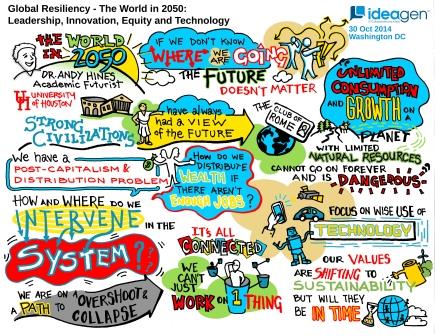 How do you do that? Well, pick a few themes, and it helps to have a good graphic facilitator (Trent Wakenight). I took the ten minute challenge at an Ideagen meeting on Global Resiliency in 2050. So here goes.
How do you do that? Well, pick a few themes, and it helps to have a good graphic facilitator (Trent Wakenight). I took the ten minute challenge at an Ideagen meeting on Global Resiliency in 2050. So here goes.
Set it up on with a “why study the future” point. I used the great futurist Yogi Berra’s line, “if you don’t know where you’re going, you might end up somewhere else.”
Then, thinking really long-term reminded me of the role of the image of the future as a guide or “north star” for us, which brought me back to Polak’s seminal work. This in turn led me to the Club of Rome series and the Limits to Growth (link to my review), a powerful image that fit well with the theme of our meeting on Resilience for the long term.
This brought up a central theme of growth as it relates to 2050 and I brought in the idea of the emergence of a transformative post-capitalist economy, as a suggestion that there are signals of change around a new attitude toward growth, that a more resilient approach is plausible, if we can address the challenging problem of how to de-couple wealth and jobs, particularly as we move into a future where automation and machine intelligence can provide wealth but cut into jobs.
A couple of things to watch for:
- A key theme, borrowing from my colleague Juan Suarez and his fabulous YouTube video on wise design, is the wise use of technology going forward. Will we use Singularity-like technology for “good” or “no-so-good.”
- The “speed” of the values shift toward postmodern and integral values, which bodes much better in terms of supporting a resilient approach to growth.
To wrap it up, I came back to one of my favorite concepts for action regarding the future – Meadow’s places to intervene in the system and ran them through the highlights, noting that the key lever is at the level of paradigm out of which the system arises. Andy Hines
Leave a Reply